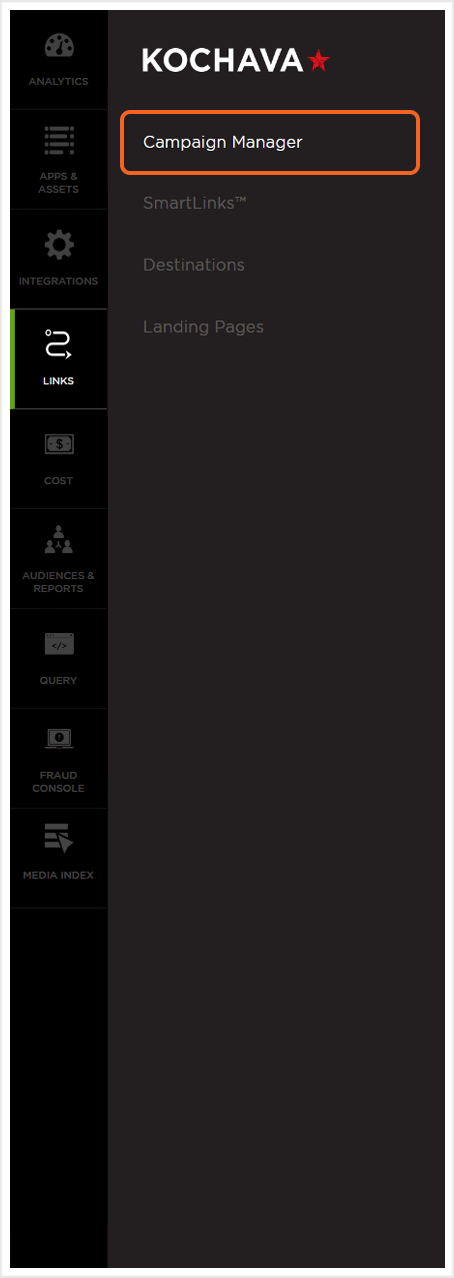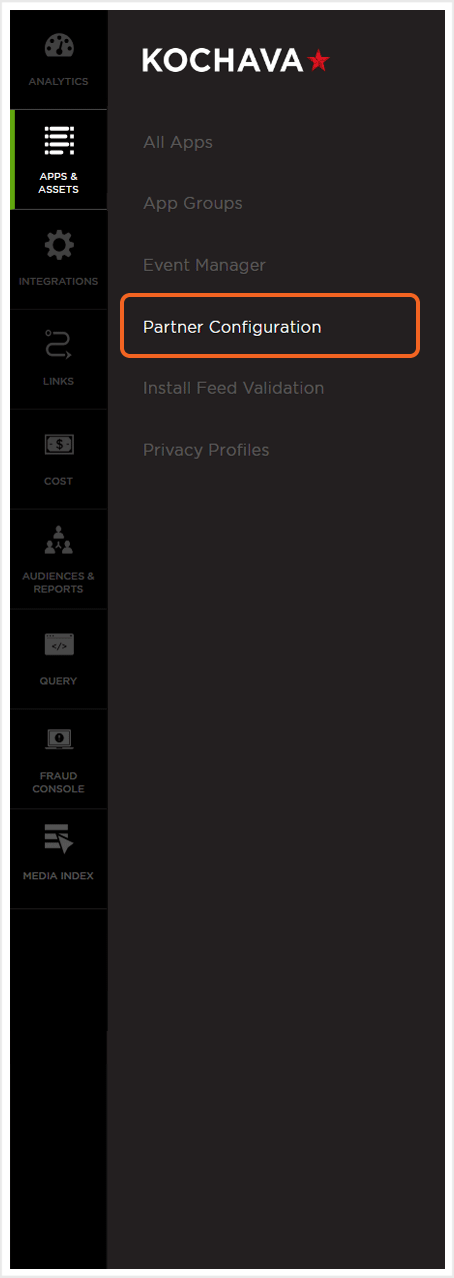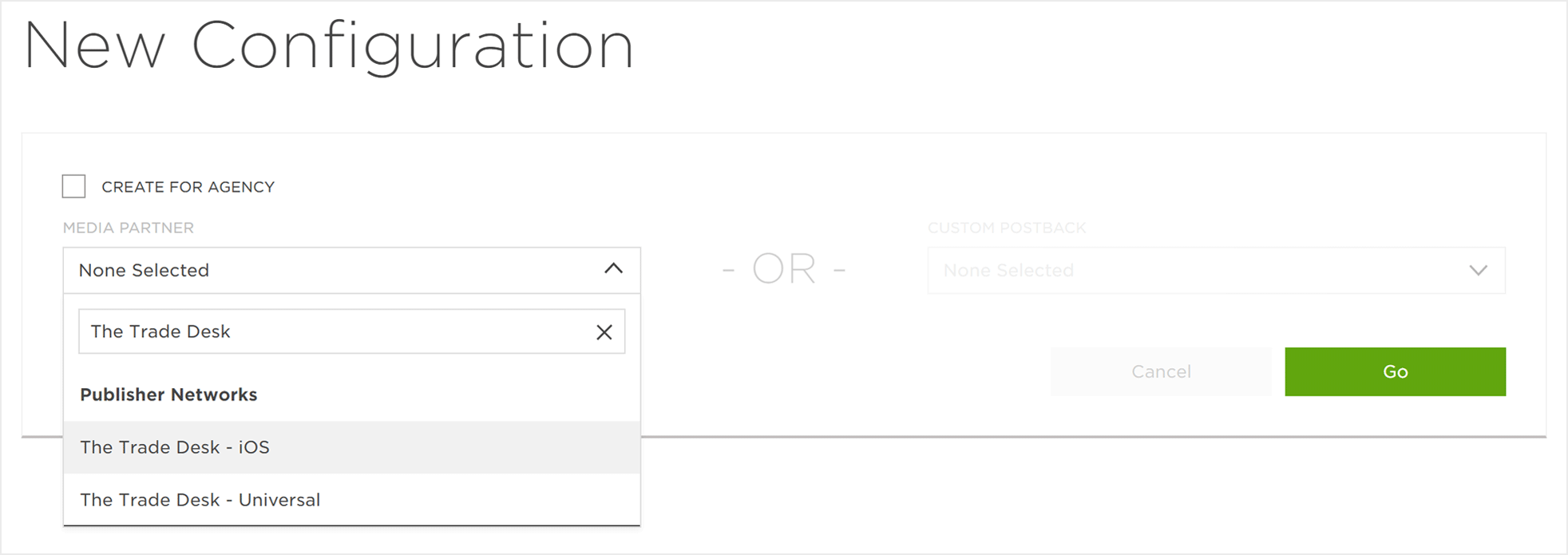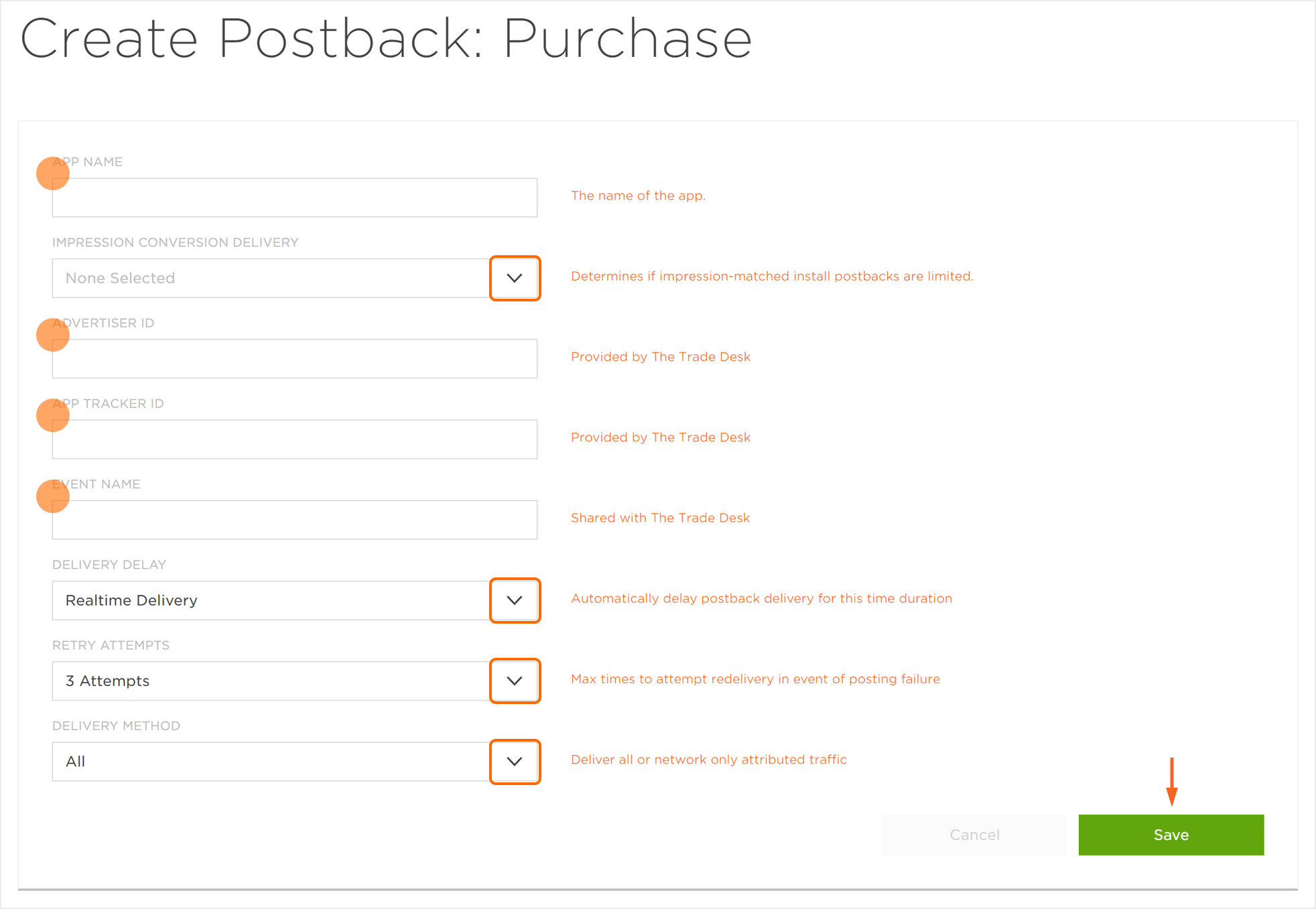Data Needed Before Beginning Process:
Create a Trade Desk Campaign
- Log in to Kochava.
- Select the desired Account and App.
- Select Links > Campaign Manager.

- Click Add a Tracker or Select Segment Tools (⋮) > Add a Tracker.
- Select the Campaign.
- Select the Segment.
- Enter the Tracker Name.
- Select Tracker Type > Acquisition. (default setting)
- Select Media Partner:
- The Trade Desk – iOS
- The Trade Desk – Android
- Select Agency Partner. (optional)
- Select the Destination URL Type:
- Custom
- Google Referrer (Android Only)
- Landing Page
- Enter the Install Destination URL.
- Enter a Deep Link. (optional)
- Add a Custom Parameter. (optional)
- Click Add New Parameter.
- Enter the Custom Parameter.
- Add additional Custom Parameters. (optional)
- Click Save. (If no further trackers need to be created)
- Click Save & Add Another Tracker. (If additional trackers need to be created)
- Click Save & Create Postback (to navigate directly to the Partner Configuration page).
NOTE: In order to streamline the Campaign/Segment/Tracker creation process a feature has been added to allow the creation of campaigns and segments while creating a new tracker. For more information about creating a campaign or segment while adding a new tracker, refer to our Create an Install Campaign support document.
![]()
NOTE: When a Tracker is created, Kochava automatically generates a name for the Tracker. We recommend that you replace the Tracker name at this point with a clear name of your choosing.
NOTE: The Share With Publisher setting allows the associated publisher to view the settings for this tracker. By unchecking this box, the associated publisher will not be able to view the settings for the tracker.
NOTE: For more information on creating and using Landing Pages, refer to our Landing Page Creation and Maintenance support documentation.
NOTE: Google Referrer is set as the default destination type for Android apps. For the majority of Android install campaigns, Google Referrer is used for optimal conversion tracking. Google Referrer will only appear for Android based apps. If the Google Referrer Install URL needs to be updated, refer to our Update Google Referrer Install URL support documentation.
NOTE: For more information about deep links, refer to our Deep Linking support documentation.
NOTE: At the Campaign Level, advertisers can utilize the Custom Parameter fields to track any custom aspect of their campaigns that they define. You can use cp_0 through cp_9 and they will be populated within their own columns in reporting. For assistance with Custom Parameters, contact your Client Success Managers.
NOTE: When a custom parameter is created, it is inserted automatically into the Click URL.
NOTE: In order to remove a custom parameter, Click the “X” associated with the specific parameter.
![]()
B. Custom Settings.
Data The Trade Desk Sends to Kochava:
Below is a list of the data that is sent to Kochava from The Trade Desk.
| adv={adv} | The TTD ID used to identify each advertiser. |
| ad_platform=TTD | Information used by Kochava. |
| click_id=%%TTD_IMPRESSIONID%% | The Trade Desk click ID |
| creative_id=%%TTD_CREATIVEID%% | The TTD ID used to identify each creative. |
| creative_size=%%TTD_ADFORMAT%% | Creative size (width x height). |
| site_category=default_site_category | Information used by Kochava. |
| site_id=%%TTD_SITE%% | The domain URL of the site that served the ad. |
| upid={upid} | The TTD ID used to identify each conversion tracker. |
| impression_id=%%TTD_IMPRESSIONID%% | The Trade Desk impression ID. |
| device_id=%%TTD_DEVICEID%% | The IDFA or ADID. |
| device_id_type=%%TTD_DEVICETYPE%% | The type of device ID sent. |
| event=served | The type of impression sent. |
Reengagement Configuration
The information within this section provides the steps necessary to establish a reengagment campaign. If a reengagment campaign does not need to be created, the information in this section may be disregarded.
NOTE: An install tracker must be created in order for postback information to be sent.
Create a Reengagement Segment:
- Locate the desired Campaign.
- Select Campaign Tools (⋮) > Add a Segment.
- Enter a Segment Name.
- Enter a Segment Description. (optional)
- Click Submit.
Create a Reengagement Tracker:
- Click Add a Tracker or Select Segment Tools (⋮) > Add a Tracker.
- Select the Campaign.
- Select the Segment.
- Enter a Tracker Name.
- Select Tracker Type > Reengagement.
- Select Media Partner:
- The Trade Desk – iOS
- The Trade Desk – Android
- Select an Agency Partner. (optional)
- Select the Destination URL Type:
- Custom
- Google Referrer (Android Only)
- Landing Page
- Enter the Install Destination URL.
- Enter a Deep Link. (optional)
- Add a Custom Parameter. (optional)
- Enter Pricing Type and Target Pricing. (optional)
- Select The Trade Desk Event.
- Click Save (If no further trackers need to be created).
- Click Save & Add Another Tracker If additional events need to be created).
- Click Save & Create Postback. (To navigate directly to the Partner Configuration page).
![]()
Postback Configuration
- Select Apps & Assets > Partner Configuration.

- Click Add a Configuration.
- Select Network Partner:
- The Trade Desk – iOS
- The Trade Desk – Android
- Click Go.
- Locate the desired post-install event.
- Click Postback Tools (⋮) > Edit.
- Enter the App Name
- Select the Impression Conversion Delivery:
- Deliver All
- Deliver Only Completed View
- Deliver None
- Enter the Advertiser ID.
- Enter the App Tracker ID.
- Enter the Event Name.
- Select the Delivery Delay.
- Select the number of Retry Attempts.
- Select the Delivery Method.
- Click Save.
NOTE: The Network Partner selection of The Trade Desk – Universal should only be used in association with a SmartLink. For more information on SmartLinks refer to our Creating and Edition SmartLinks support documentation.


